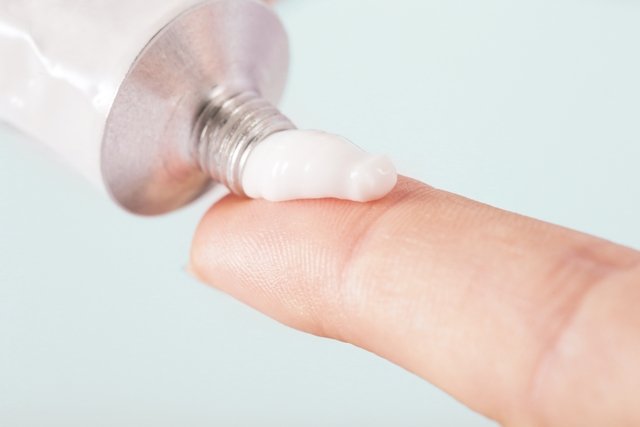Some ointments for cuts in private parts, such as dexpanthenol, clotrimazole, clostebol + neomycin or collagenase, help to heal the skin and mucous membranes, and treat the condition that caused cuts or wounds in the vagina, vulva, groin, penis or anus.
These ointments can be recommended for cuts or wounds in private parts caused by diaper rash, candidiasis, anal fissures, cauterization of the cervix or vaginal surgeries, for example.
Treatment of cuts in private parts should be carried out by a gynecologist, urologist or proctologist, who can recommend the best ointment according to the condition to be treated.
6 ointments for cuts in private parts
The main ointments for cutting private parts are:
1. Dexpantenol
Dexpanthenol ointment for cuts on private parts can be used for diaper rash, wounds or cuts on the nipples or anal area, as it forms a protective barrier on the skin, moisturizing the skin and reducing irritation and redness, as well as helping to promote healing of the skin.
Some examples of ointments containing zinc oxide are Bepantriz, Dexprotenol or Neopantol, for example.
How to use: Apply dexpanthenol ointment to clean skin, after cleansing, 1 to 3 times a day, or as directed by your doctor.
2. Clostebol + neomycin
Clostebol + neomycin ointment has anti-inflammatory and antibacterial action and is indicated for healing cuts in the skin, such as wounds in the groin, vagina, breasts or anal fissure.
This ointment can be found under the trade names Trofodermin or Trofodermin gynecological cream or under the trade name clostebol acetate + neomycin sulfate.
How to use: clean and dry the intimate area well and apply a thin layer of the ointment 1 to 2 times a day, as per medical advice.
Read too: Anal fissure: what it is, symptoms, causes and treatment
3. Clotrimazole
Clotrimazole ointment for cuts in private parts is indicated for the treatment of vaginal or penile candidiasis, as it acts by inhibiting the growth of Candida albicans, relieving the symptoms of candidiasis, including intense itching that can cause cuts or wounds in the intimate area due to the act. to scratch.
This ointment can be found under the commercial name Gino-canesten vaginal cream or under the generic name Clotrimazole, containing 3 or 6 vaginal applicators for use in women, but it can also be used for male candidiasis.
How to use: In the case of women, apply clotrimazole vaginal ointment once a day, preferably at night, for 3 or 6 days, according to medical advice. This ointment must be applied deeply into the vaginal canal, using the applicator provided in the packaging and must not be used during menstruation.
In the case of men, clotrimazole ointment should be applied to the glans and foreskin twice a day, for 1 to 3 weeks, as advised by the urologist. See ointments for candidiasis.
It is recommended to avoid sexual intercourse during treatment, as candidiasis can be transmitted to the partner and clotrimazole cream can reduce the effectiveness of the condom or diaphragm.
Read too: Treatment for candidiasis: remedies and home options
4. Promestriene
Promestriene ointment for cuts in the intimate region is indicated for the treatment of vulvovaginal atrophy caused by estrogen deficiency during menopause, or to help with healing after gynecological surgeries, normal postpartum, or after local therapies with physical agents.
This ointment is found under the generic name “promestriene” or under the commercial name Antrofi 10 mg/g containing 20 vaginal applicators
How to use: For intravaginal use, promestriene gynecological ointment must be applied once a day, preferably at night, using the applicator, for 20 days, or as instructed by the gynecologist. In the case of external use, you should not use the applicator, but simply apply the external vaginal ointment to the area to be treated, 1 to 2 times a day, for 20 days.
5. Silver sulfadiazine
Silver sulfadiazine ointment for cutting private parts is indicated for the post-operative treatment of vaginal surgeries, cauterization of the cervix, biopsy of the cervix and vulva, ulcers and wounds on the vulva.
This ointment has healing and antimicrobial action, which helps to heal the vaginal mucosa, in addition to eliminating microorganisms sensitive to this substance.
Silver sulfadiazine ointment is found as the generic “silver sulfadiazine” or under the commercial name Gino Dermazine cream 1%, containing 10 vaginal applicators.
How to use: for colpitis or post-operative use, you must use the applicator provided in the packaging, applying the ointment deeply into the vaginal canal, once a day, preferably at night, for 6 days. For wounds or ulcers on the vulva, you should not use the application, but only apply the ointment to the external genital region, directly on the wound. You should not interrupt treatment during menstruation.
Read too: Cervical cauterization: what it is, how it is done and recovery
6. Collagenase
Collagenase + chloramphenicol ointment for cutting private parts is indicated for the treatment of cauterization and surgeries on the cervix, gynecological surgeries, after childbirth, cervicitis, vaginitis, episiotomy, episiorrhaphy and colpoperineorrhaphies.
This ointment contains an enzyme capable of removing dead skin cells from wounds, promoting cleaning and facilitating healing, in addition to having chloramphenicol with antibacterial action.
Collagenase ointment can be found under the trade name Gino-Kollagenase, containing 6 vaginal applicators.
How to use: Collagenase + chloramphenicol ointment should be applied inside the vaginal canal with the help of the applicator, at night when going to bed. The dosage is 1 application per day, for the treatment time indicated by the gynecologist according to the condition to be treated.
Read too: How to care for an episiotomy after childbirth
When to go to the doctor
It is important to consult a gynecologist, urologist or proctologist whenever a cut appears in the private parts and is accompanied by symptoms, such as:
- Redness;
- Itch;
- White, gray or greenish discharge;
- Wounds.
Furthermore, after gynecological surgeries it is important to follow up with the gynecologist and treat with ointments or other medications, as recommended by the doctor.

Sign up for our newsletter and stay up to date with exclusive news
that can transform your routine!
Warning: Undefined array key "title" in /home/storelat/public_html/wp-content/plugins/link-whisper-premium/templates/frontend/related-posts.php on line 12
Warning: Undefined array key "title_tag" in /home/storelat/public_html/wp-content/plugins/link-whisper-premium/templates/frontend/related-posts.php on line 13




